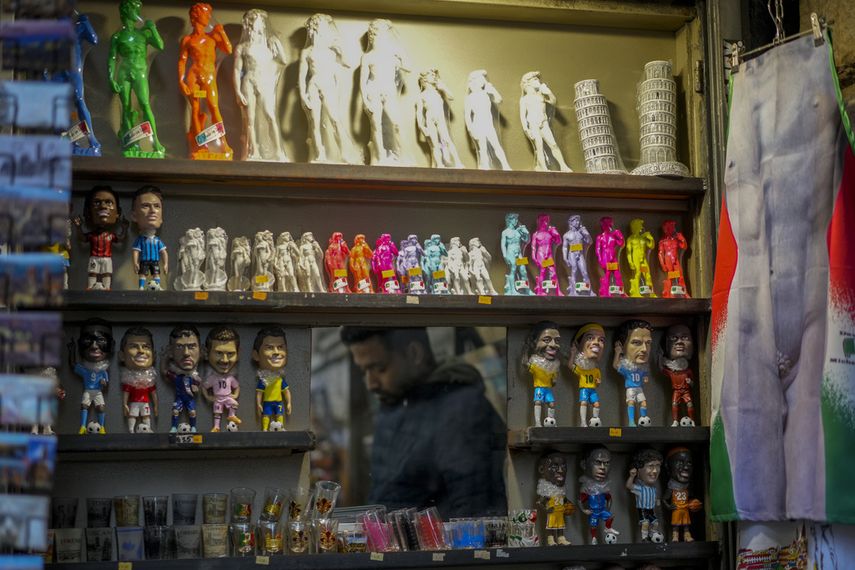The director of the Galleria dell’Accademia (Florence Academy Gallery) that houses David, Cecilie Hollberg, has positioned herself as a defender of the work since her arrival at the museum in 2015, quickly targeting those who benefit from its image. , often in ways she considers degrading.
In that sense, Hollberg is a bit like a David versus the Goliath of unbridled capitalism with his army of street vendors and souvenir shop workers selling aprons of the statue’s naked figure, t-shirts of her with obscene gestures, and figurines, to often in pop art neon.
Commercial protection of the work
At Hollberg’s urging, the state prosecutor’s office in Florence has launched a series of court cases invoking Italy’s historic cultural heritage code, which protects artistic treasures from unauthorized and derogatory commercial use. The academy has won hundreds of thousands of euros (dollars) in damages since 2017, Hollberg said.
“There was great joy around the world at this truly unique victory that we achieved, and questions and inquiries from all sides about how we did it, for advice on how to proceed,” he told The Associated Press.
Legal action has been taken to protect masterpieces in other museums, not without debate, such as The vitruvian man of Leonardo, the David by Donatello and The birth of Venus by Botticelli.
The decisions challenge a widely held practice that intellectual property rights are protected for a specific period before entering the public domain: the life of the artist plus 70 years, according to the Berne Convention, signed by more than 180 countries, including Italy.
More broadly, the decisions raise the question of whether institutions should be the arbiters of taste and to what extent freedom of expression is being limited.
“It raises not only legal questions, but also philosophical ones. What does cultural heritage mean? How much control do you want to give institutions over ideas and images that are in the public domain?” said Thomas C. Danziger, an art market lawyer. based in New York.
Controversy in inspiration
Danziger pointed to the famous Andy Warhol series inspired by the last supper by Leonardo. “Are you going to stop artists like Warhol from creating what is a derivative work?” Danziger asked. “Many people would see this as an appropriation by the Italian courts to control and monetize works of art in the public domain for which payment was never intended.”
The Italian cultural code is unusual in scope, essentially extending in perpetuity the copyright of the creator of the work to the museum or institution that owns it. The Vatican has similar legislative protections over its masterpieces, and seeks remedies through its judicial system for any unauthorized reproduction, including for commercial use and for damaging the dignity of the work, a spokesman said.
Elsewhere in Europe, Greece has a similar law, adopted in 2020, that requires permission to use images of historical sites or artifacts for commercial use, and prohibits the use of images that “alter” or “offend” monuments of any kind. manner.
The French Louvre museum, which houses some masterpieces such as the Mona Lisa and the Venus de Milo, points out that his collection mostly dates from before 1848, which puts them in the public domain in accordance with French law.
Court cases have debated whether Italian law violates a 2019 European Union directive that states that any work of art that is no longer protected by copyright becomes public domain, meaning: “everyone “should be free to make, use and share copies of that work.”
Ignorance or reiteration?
The European Commission has not addressed the issue, but a spokesperson told the AP that it is currently checking the conformity of national laws implementing the copyright directive and will analyze whether Italy’s cultural heritage code interferes with its application.
Hollberg won his first case against ticket resellers who used David’s image to sell marked ticket packages outside the academy gates. He also pointed out GQ Italia for making an edition with a model imitating the David, and the shameless Longchamp luxury edition of its characteristic bag. The folding with the most intimate details of David.
Longchamp noted that the performance was not without irony and said that the bag was: “an opportunity to express with amusing lightness the creative force that has always animated this wonderful city.”
No matter how many lawsuits Hollberg has filed – he did not say how many – the proliferation of images taken from the David continues.
“I regret that there is so much ignorance and so little respect in the use of a work that for centuries has been admired for its beauty, for its purity, for its meanings, its symbols, to make products of bad taste, of plastic,” said Hollberg. .
Other cases
Building on Hollberg’s success and strengthened by improved search engine technology, the private entity that guards Florence’s iconic cathedral has begun pursuing commercial companies that use its famous dome for unauthorized and sometimes illegal purposes. degrading clothing, including men’s and women’s underwear.
So far, cease-and-desist letters have been enough to achieve compliance without going to court, adding an additional half a million euros ($541,600) a year to revenues exceeding €30 million ($32 million), Luca Bagnoli, president of the Santa Mara del Fiore opera house, told the AP.
“In general, we are in favor of freedom of artistic expression,” Bagnoli said. “When it comes to reinterpretations, it becomes a little more difficult to understand where artistic freedom ends and our image rights begin.”
Italy’s cultural heritage code in its current form has been in force since 2004, and although the Hollberg cases were not the first, they have represented an acceleration, experts said.
The case law is still being tested. A Venice court ordered German puzzle maker Ravensburger to stop using the image of the Vitruvian Man in the first case involving a company outside Italy. The ruling implicitly rejected Ravensburger’s argument that the law was incompatible with the EU copyright directive, the lawyers said.
Experts say the aggressive stance could backfire, discouraging the licensing of works of art from Italy, a source of income, while limiting the reproduction of masterpieces that serve as cultural ambassadors.
“There is a risk for Italy, because you can select a work of art that is not covered by this legislation,” said Vittorio Cerulli Irelli, an intellectual property lawyer at Trevisan & Cuonzo in Rome. In many cases, it is the same for you to use the Leonardo painting, which is in the UK, or the Leonardo painting, which is in Italy. “Just choose the easiest option.”
FUENTE: AP



